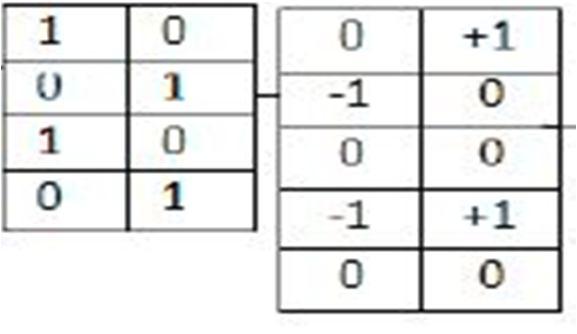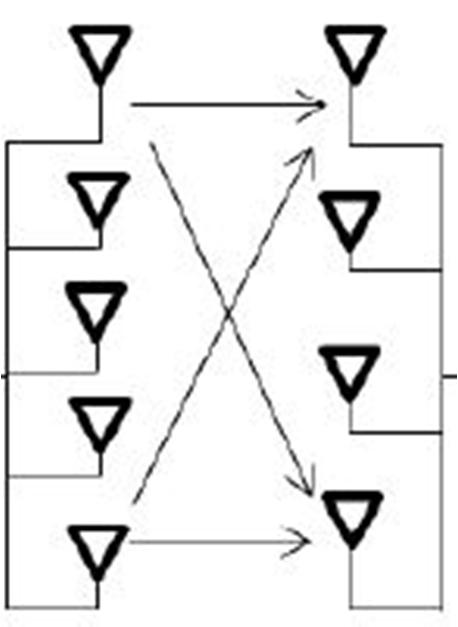
ISSN: 2321 9653; IC Value: 45.98; SJ Impact Factor: 7.538 Volume 10 Issue IX Sep 2022 Available at www.ijraset.com



ISSN: 2321 9653; IC Value: 45.98; SJ Impact Factor: 7.538 Volume 10 Issue IX Sep 2022 Available at www.ijraset.com

Rohit Singh1 , Dr. Ashutosh Singh2 , Dr. A.K. Shankhwar3 1, 2, 3Electronics Engineering Department, HBTI Kanpur 208002, INDIA
Abstract: Spatial modulation (SM) is an emerging digital modulation technology that fulfills the requirement of higher Spectra efficiency and high energy efficiency and has a very wide range of applications. The concept used in Spatial Modulation can further be extended to other domains such as frequency, time, angle or even across multiple domains. The basic idea behind SM is to convey extra information with the ON/OFF states of transmitting antennas.
In single RF Spatial Modulation, only one antenna is activated at a time. Therefore, it requires only one RF chain which reduces the cost as compared to MIMO [1] system.
In other variants of Spatial Modulation, more than one antenna may be activated at the same time. Different forms of Spatial Modulation have been described in this paper. Single RF spatial modulation, generalized spatial modulation, and differential spatial modulation. A comprehensive comparative analysis has been presented with plots of spectral efficiency against bit error rate. It has been concluded that spectral efficiency increases up to 15 times in differential spatial modulation as compared to single RF spatial modulation. Whereas, the energy efficiency increases up to 4 times in generalized spatial modulation as compared to single RF spatial modulation.
Spatial modulation has low diversity gain because only one antenna is active at a time and it also requires channel state information at the receiver side for demodulation of the received signal which makes SM costly so a new technique Space-Time Block Code (STBC) is introduced in spatial modulation which increases diversity gain and reduces overall system cost because this technique does not require channel state information at receiver side for demodulation of the signal.
Index terms: massive MIMO, spatial modulation (SM) or single RF MIMO, Generalised spatial modulation (GSM), Differential spatial modulation (DSM), Space Time Block Code (STBC).

The demand of high data rate and high bandwidth increases with the increase in population so researchers mainly focus on other technology having ultra high capacity, ultra low latency, low power consumption, and massive connectivity over scarce wireless resources [2,3] to full fill requirements of people. Due to very high mobile data traffic researchers are motivated to develop new transmission technology having maximum achievable throughput and minimizing the development cost so in the beginning of 21st century spatial modulation has been developed to full fill requirements but in the early 21st century prelim SM [4] has developed which do not gain much attention but after 2008 due to development of GSM and DSM [5], SM becomes prominent technology for wireless communication. SM often transmits additional information bits through the index of one active transmit antenna. The active antenna index varies based on the antenna switching mechanism in accordance with the bits of spatial information. So SM is termed as a new technique in different modulation technique which conveys additional information through the activation state of transmission antennas. Particular, only one RF chain is needed at the SM transmitter to activate one of many transmit antennas for a constellation symbol transmission. So SM considerably decreases downlink communications energy consumption and uplink communications' hardware costs at the user interface.
For high mobility wireless communication systems, where the channel correlation is weaker but the inter channel interference is free, SM can be a better candidate technology than Vertical Bell Laboratories Layered Space Time (VBLAST) In GSM k antenna out of total Nt antenna are chosen for transmission of signal using spatial modulation technique .because k antenna active at a time so k RF chain are required which increase diversity gain and spectral efficiency. In DSM all Nt antenna are activated at a time and differential encoded space time shift keying (STSK) uses Cayley Unitary Transform and conveys information by activation state of Space Time Dispersion Matrix.
Factor
International Journal for Research in Applied Science & Engineering Technology (IJRASET)

ISSN: 2321 9653; IC Value: 45.98; SJ Impact Factor: 7.538 Volume 10 Issue IX Sep 2022 Available at www.ijraset.com
Single RF Spatial modulation is a special case of MIMO system in which only one antenna is activated to save energy and the active antenna index is used to convey additional information based on the antenna switching mechanism[6] for example if we consider BPSK and the number of transmitter antenna 4 to convey 3 bit of information we have to transfer only 2 bit only and information of which antenna is used to transfer particular bit is to be transferred to receiver side for demodulation on signal at receiver side .antenna
Data bit Transmit vector Antenna 1 Antenna 2 Antenna3 Antenna 4 00 [1,0,0,0] on off off off 01 [0,1,0,0] off on off off 10 [0,0,1,0] off off on off 11 [0,0,0,1] off off off on
Table1 Single RF spatial modulation having 4 transmitting antenna
In single RF spatial modulation, we require information of modulation index such as one phase shift keying (PSK) / quadrature amplitude modulation (QAM) symbol and we require the index of one active antenna for each Chanel use during transmission. Spectral efficiency depends on two things modulation index and the number of transmit antenna so Spectral efficiency is given as
The first part of Spectral efficiency log2 Nt specifies the modulation index of the active antenna whereas the second part of Spectral efficiency log2 M bits are used for modulation of constellation symbol.
The spatial modulation system model is has Nt , Nr Antennas the on transmitter and receiver side respectively. the data to be transferred is converted serial to parallel then data sequence is mapped according to SM technique shown above .as constellation symbol s [7] is carried out by Jth antenna then transmit vector x contains only one non zero elements since only one antenna is activated at a time transmitter vector x is represented as x = [0 0 0 0 ……0.s.0……0]
J 1 antenna before Jth antenna and Nr J Antenna after Jth antenna are not active so they transmit symbol zero. Now received vector Y can be represented as Y= Hx +n
(3)
Where H is the complex channel matrix, x is the transmitted unit vector and n is the additive noise matrix Here H is Rayleigh fading channel matrix which is known at receiver side channel with T transmitter and R receiver then Rayleigh fading channel matrix is represented as h11 h12 h1T h21 h22 … h2T H =

hR1 hR2 … hRT
Precoding matrix P [8] is use to choose the sequence in which transmit antenna activated. precoding matrix represent code word off available beam forcing vector. If precoding matrix become identity matrix then generalized scheme is reduce to conventional SM.
ML detector is used to detect signals at receiver side. ML estimator is use to estimate staticall model parameter .when ML detector is being introduce in SM then it requires information about a number of transmitter antenna and modulation index use in system or detection of the signal at the receiver side. if we want to reduce the complexity of ML estimator then we have to reduce the number of transmitter antenna .
Impact Factor
Impact Factor 7.894
International Journal for Research in Applied Science & Engineering Technology (IJRASET)

ISSN: 2321 9653; IC Value: 45.98; SJ Impact Factor: 7.538 Volume 10 Issue IX Sep 2022 Available at www.ijraset.com
In SM modulation only one antenna is activated at a time for data transmission therefore only one non zero value is present in the received signal. Received vector x is X=[0 0 0 0 ……0.s.0……0]
Where v is complex signal from set of signals s where |s|= Nt , channel matrix is H and transmitted vector is X and received signal is Y.
Output of ML detector is = arg min ‖Y HX‖ 2 .
B. Space time block code in spatial modulation system
SM achieve high spectral efficiency and require less number of RF chains as compare to MIMO system because only one antenna is activated at a time in SM .but as only one antenna is activated at a time so SM fail to achieve diversity gain. and second drawback of SM is that it requires channel state information at the receiver side for signal decoding .both these drawback of SM are overcome by using STBC ( space time block code )[9] technique in SM .STBC also improves system reliability.

Consider a space time block code spatial modulation system having Nt , Nr transmit antenna and receive antenna respectively. At time instant T total k+l bits are fed to transmitter antenna where k are used to select one space constellation S from K space constellation matrix S=(S1,S2,………….SK) ,K=2k and rest l bits are used for mapping Symbols (xo,x1…….,xL 1) with Q PSK/ M PSK /QAM modulation( l=L log2M) then k+l bits are coded into STBC code word X . finally STBC SM code word C=XS Then code word is finally transmitted through any activated transmitter antenna[9] . Chanel used for transmission is a quasi static Rayleigh fading channel which remains constant for any time slot T. At receiver side received signal matrix Y[10] is given as
Where H denote Nt ×Nr channel matrix N denote T ×Nr channel matrix and ƿ denotes average signal to noise ratio (SNR) .
For STBC SM scheme having 4 transmit antennae and 2 antennas are activated at a time. first time instant 1st ,2nd antenna are active and 3rd ,4th antenna are off so in this time instant we transmit x1 through 1st antenna x2 through 2nd antenna . In the second time instant also 1st ,2nd antenna are active and 3rd ,4th antenna are off so in this time instant we transmit
through 1st antenna and ∗ through 2nd antenna So space constellation code word C0
And if 3rd, 4th antenna are
and 1st ,2nd antenna
Since we are activating 2 same antenna at two different time so diversity order is 2 with 4 transmit antenna and to increase diversity order we use quasi orthogonal STBC (QOSTBC) which covers 4 time slots so diversity get double for 4 transmit antenna code word in QOSTBC can be built by digitalizing 2 STBC SM code word .
Rights are Reserved | SJ Impact Factor 7.538 | ISRA Journal Impact Factor 7.894 |
Factor:
Issue IX Sep 2022 Available at www.ijraset.com
When Symbol , are transmitted through 1st ,2nd transmit antenna then 3rd and 4th antenna are off similarly when Symbol , are transmitted through 3rd and 4th antenna then 1st ,2nd transmit antenna are off . In order to achieve height diversity preceding matrix P is chosen as
Finally new QOSTBC symbols (C
Based on symbols (
C
C
C ) can be obtained like
) new QOSTBC code is presented as
Hence 4 different symbols symbol ( , , , ) will be transmitted via four different transmit antennas at 4 different time slots. Now to achieve full diversity ( diversity order is 4 for 4 transmit antenna ) we rotate each constellation matrix by multiply S ,S , S , S by 1, e , e , e respectively. And second purpose of rotation is that code words don’t overlap with each other. Antenna Pair
Generalise spatial modulation is another case of spatial modulation where more than one antennas are simultaneously activated so that same PSK / QPSK symbols is transmitted from all active antennas because symbol transmitted from all antennas is the same so they require same RF chain instead of multiple RF chains .so it reduces cost and ICI [12] does not occur in Generalise spatial modulation because of single RF chain. Suppose we activate K antennas out of Nt antennas at a time where Nt > K then remaining Nt K antennas remain inactive which saves power . for Nt active antenna out of k antennas having modulation index M spectral efficiency is
2 Spatial constellation matrix for different set of active antenna


International Journal for Research in Applied Science & Engineering Technology (IJRASET)

ISSN: 2321 9653; IC Value: 45.98; SJ Impact Factor: 7.538
Volume 10 Issue IX Sep 2022 Available at www.ijraset.com
SGSM1 = [ log2 ( Nt /K )] + log2 M [bpcu].
Spectral efficiency is increase in GSM as compare to single RF spatial modulation but constellation information is limited by one PSK / QAM symbol so to further increase spectral efficiency new concept is introduce which allows different antenna to carry different information . For Nt active antenna out of k antennas having modulation index M spectral efficiency in this case is
SGSM2 = [ log2 ( Nt /K )] +k log2 M [bpcu]
In this case as different antenna’s carry different PSK / QAM symbol so for Nt active antenna Nt RF chains are required which increase cost of system and increase spectral efficiency .So GSM allows to compromise between cost and spectral efficiency. For K=1 GSM become single RF spatial modulation and for K=Nt fully activated MIMO.
In first section working of GSM [13] system is shown where we activate Nt antenna out of K antenna’s and taking modulation index for PSK M =2 and in second section GSM STBC (generalised spatial modulation with space time block code) is represented where STBC is applied in GSM to avoid requirement of Chanel state information at output side and to archive height data rate with low data error’s.
Main challenge among researchers is to achieve height data rate and low latency in communication system so they develop new technology in 2008 known as GSM which provide height data rate as compare to spatial modulation system in GSM high data rate is achieve by seeding same consolation symbol for each active antenna proposed system model is shown in figure 1 in GSM among total available antennas are divided into several group of antenna’s and different group of antenna is activated at different time and at particular time instant each antenna of particular group sent same constellation symbol .
The proposed system model is designed for Nt =5 and Nu= 2 where Nt ,Nu are number of transmit antenna and number of active antenna .we make group of 2,2 antennas at the transmitter side for sending same constellation symbol because number of active antenna is 2 in this way total number of combinations become 2P1 where P1 = log (Nt/Nr) mapping of data is given in 2.2

To map information data bits in spatial and data symbols taking QPSK is illustrated in table 3


SJ Impact Factor 7.538 |





Impact Factor 7.894 |

International Journal for Research in Applied Science & Engineering Technology (IJRASET)

ISSN: 2321 9653; IC Value: 45.98; SJ Impact Factor: 7.538 Volume 10 Issue IX Sep 2022 Available at www.ijraset.com
Group of Bits Set of antennas (k)
Transmitted symbol (s) 0001 (1,2) +1 0000 (1,2) 1 0011 (1,3) +1 0010 (1,3) 1 0101 (1,4) +1 0100 (1,4) 1 0111 (1,5) +1 0110 (1,5) 1 1001 (2,3) +1 1000 (2,3) 1 1011 (2,4) +1 1010 (2,4) 1 1101 (3,5) +1 1100 (3,5) 1 1111 (4,6) +1 1110 (4,6) 1
Table 3. GSM mapping table for Nt = 5, Nu = 2 [14]
In the example of the grouped bits g(n) = [0 0 0 1], the first three bits 000 refer to the antenna Combination (1,2) and the rest bit 1 refers to the transmitted symbol +1. So, if g(n) = [1 11 0], the antenna combination will be (4,6) and the transmitted symbol will be 1
In GSM total P1 bits are used for selecting set of antenna combinations which send constellation symbol at that time and P2 bits are used for modulation index selection ex M = ……. So total bit which are send through the channel are P1+P2 where P1 = log2 ( Nt / Nr) and P2= log2 M so total spectral efficiency of GSM system is SGSM = [ log2 ( Nt / Nr)] + log2 M [bpcu].
In GSM, modulated signal is transmitted through ray light fading channel H having dimension Nr × Nt where Nr is number of antenna at receiver side and Nt is number of antenna at transmitter side
At transmitter side input data stream q(n) is divided into bits equal to number of active antenna at particular time instant here number of active antenna at particular time is 2 so we group incoming data bits in group of 2,2 then send it through ray light fading channel H .at receiver side output sequence g(n) is mapped using GSM The received signal at any given time instant is given by = ′ k, +
where is the symbol transmitted through the particular set of antenna combination, ∈ M QAM ,k = [ k1, k2,…….,k Nu ]∈∅, kN refers to the index of nth antenna in the set of antennas, k and ∅ refer to the set of antenna combination, and Additive White Gaussian Noise (AWGN) vector with zero mean is represented by for decoding spatial symbol at receiver side ML algorithm is used and the data symbol are as follows [k, ] = arg min∑
STBC is technique that is use to achieve higher data rate higher diversity and low bit error rate .and STBC avoid use off multiple RF chain in GSM while sending different symbol through different antenna .so problem off high cost and high power is solved by using STBC technique in GSM system.
Information bits are converted from serial to parallel so that it can be given to 2 different GSM encoders [15] each encoder has Nt ,Nu number of transmit antenna and active antenna respectively at particular time .both GSM encoder will send symbols at time slot t , t+t1 as shown in figure
Rights are Reserved | SJ Impact Factor 7.538 | ISRA Journal Impact Factor 7.894 |

International Journal for Research in Applied Science & Engineering Technology (IJRASET)


ISSN: 2321 9653; IC Value: 45.98; SJ Impact Factor: 7.538 Volume 10 Issue IX Sep 2022 Available at www.ijraset.com
In first time slot symbol is transmitted through the upper GSM encoder and symbol s is transmitted through the lower GSM encoder in second time slot symbol ∗ is transmitted through upper GSM encoder and symbol
is transmitted through lower GSM encoder. Let S = [s0, s1]T be the un coded M QAM information symbol vector that will be transmitted over two sequential OFDM symbols, so the Alamouti scheme generates the following code word matrix




Figure 2. GSM STC (space time coding technique) system model [15]
In Table 4, hm,n indicates the channel between transmitter and receiver, where n is the number of antenna at receiver side , n = 1, 2, 3, 4, and m is the number of antenna at transmitter side , m = 1, 2, 3 .. 10.
First time slot r0 = h0s0 + h1s1 + μ0 r4 = h4s0 + h5s1 + μ4
Second time slot r1 = h0 ∗ + h1
+ μ1 r5 = h4 ∗ + h5 ∗ + μ5
2 = h2s0 + h3s1 + μ3 r6 = h6s0 + h7s1 + μ6
r3 = h2
+ h3
+ h7
Table 4. The received signal using two antennas at receiver. [15]




+ μ7
+ μ3 r7 = h6
and r7 are the complex random variable received at the receiver side including noise and interference. The 2 symbol given to ML decoder after being built from combiner are as fallows

Here r0,r
In GSM STBC technique diversity order from two transmit antenna is similar to the diversity order from the four transmit antenna model. Which allow us to use two transmit antenna instead of four transmit antenna which saves power and money both.

Spatial modulation is a technique in which additional information is conveyed through the activation state of transmit antenna. At the receiver side SM detects spatial information by differencing different channel fading states associated with various transmitting antenna .so it requires channel state information (CSI) [16] at the receiver side for coherent detection. But the requirement of CSI increases the deployment cost due to increase of channel estimation complexity. To overcome the requirement of CSI at the receiver side Space Time Block Code (STBS) technique is introduce in SM but in STBC 2 or 4 or 8 antenna can be activated at a time
All Rights are Reserved | SJ Impact Factor 7.538 | ISRA Journal Impact Factor 7.894 |
International Journal for Research in Applied Science & Engineering Technology (IJRASET)

ISSN: 2321 9653; IC Value: 45.98; SJ Impact Factor: 7.538 Volume 10 Issue IX Sep 2022 Available at www.ijraset.com
Total bits to be transfer through DSM [17] is converted from serial to parallel. Then total n bits are divided in two group p1 and p2 p2 bits permutation
Constellation domain data










First p1 group of bit is use for permutation selection to determine permutation p(i) so p1=log (Nt!) is applied to permutation selector .And second p2 bits are used for symbol modulation so to determine symbol modulation so P = log M bits are applied to symbol modulator for generating Nt different constellation symbols which are arranged diagonally as fallows diag{ s1(i) …………..sNt} hence resulting information block is given as X(i) = diag{ s1(i) …………..sNt} p(i) (12)
Hear diagonal means matrix is in didonal form. Final DSM block matrix is calculated as S(i) = S(i 1) X(i)
Final DSM block matrix S(i) is Nt×Nt matrix having one non zero element in each column. Using delay as shown in figure DSM completely avoid requirement of channel state information at receiver side for non coherent detection. Differential encoded space time shift keying (DSTSK) schema also known as differential spatial modulation use Cayley Unitary Transform to convey extra information through the activation state of space time dispersion matrix. DSM is applicable to any arbitrary number of active transmit antenna. For Nt transmit antenna DSM will transmit Nt × Nt space time block code which is one permutation of block activation code.
In MIMO System all antenna are activated at a time so it requires large amount of power and it also require RF chain equals to number of transmitter antenna which makes system costly and complicate. SM space domain to convey activated antenna index information which is extra information without requirement of any additional bits to be transferred through channel so spectral efficiency and energy efficiency both increases in SM as compare to MIMO but there is one drawback that activated antenna must be in power of 2 eg 2,4,8,16 . In GSM we chose k antenna out of total Nt antenna to activate at a time which increases energy efficiency and in GSM there is no constrain that activated antenna must be in power of 2 . In DSM all antenna are activated at a time and differential encoded Space Time Shift Keying (STSK) uses Cayley Unitary Transform and convey information by activation sate of space time dispersion matrix in DSM spectral efficiency is increase up to 15 time as compare to SM. Spatial modulation requires channel state information at receiver side to retrieve signal which make system costly and complicate so space time block code technique is use which don’t require channel state information to retrieve signal at receiver side Graph in figure 4 represent increase in spectral efficency with increase in nummer of transmitting antenna. Graph is ploted using modulation index M= 4. In GSM k= NT 2 means we activate two antenna less than total transmitting antennas. eg we activate 2 antenna out of 4 and 6 antenna out of 8 transmitting antenna are activated. GSM has low spectral efficency as compare to SM but GSM has heigh energy efficency as compare to SM . In DSM spectral efficency is increase to 15 times as compare to SM.
Rights are Reserved | SJ Impact Factor 7.538 | ISRA Journal Impact Factor 7.894 |
Science & Engineering Technology (IJRASET
ISSN: 2321 9653; IC Value: 45.98; SJ Impact Factor: 7.538

Volume 10 Issue IX Sep 2022 Available at www.ijraset.com
Fig 4 Graph of increase in spectral efficiency with increase in transmitting antenna in SM,GSM,DSM

[1] O. E. Ayach, S. Rajagopal, S. Abu Surra, Z. Pi and R. W. Heath, "Spatially Sparse Precoding in Millimeter Wave MIMO Systems," in IEEE Transactions on Wireless Communications, vol. 13, no. 3, pp. 1499 1513, March 2014, doi: 10.1109/TWC.2014.011714.130846.

[2] L. Lu, G. Y. Li, A. L. Swindlehurst, A. Ashikhmin, and R. Zhang, “An overview of massive MIMO: Benefits and challenges,” IEEE J. Sel. Areas Commun., vol. 8, no. 5, pp. 742 758, Oct. 2014.
[3] V. W. Wong, R. Schober, D. W. K. Ng, and L. C. Wang, Key technologies for 5G wireless systems. Cambridge university press, 2017.
[4] R. Y. Mesleh, H. Haas, S. Sinanovic, C. W. Ahn, and S. Yun, “Spatial modulation,” IEEE Trans. Veh. Technol., vol. 57, no. 4, pp. 2228 2241, Jul. 2008.
[5] M. D. Renzo, H. Haas, A. Ghrayeb, S. Sugiura, and L. Hanzo, “Spatial modulation for generalized MIMO: Challenges, opportunities, and implementation,” Proc. IEEE, vol. 102, no. 1, pp. 56 103, Jan. 2014.
[6] K. Ntontin, M. Di Renzo, A. I. Perez Neira, and C. Verikoukis, “A lowcomplexity method for antenna selection in spatial modulation systems,” IEEE Commun. Lett., vol. 17, no. 12, pp. 2312 2315, Dec. 2013.

[7] Anu Johnson , Vibha Tiwari ,’’ An Analysis and Detection Results of Spatial Modulation using Modulation Schemes,’’ International Journal of Innovative Science and Research Technology, Volume 3, Issue 1, January 2018

[8] M. Di Renzo, H. Haas and A. Ghrayab, S. Sugiura and L. Hanzo,”Spatial Modulation for Generalized MIMO: Challenges, opportunities and implementation,”Proc. IEEE, vol. 102, no.1, pp. 56 103, Jan 2014.
[9] M. Di Renzo, H. Haas and P.M. Grant,”Spatial Modulation for Multiple antenna Wireless system: A Survey,”IEEE Commun. Mag., vol. 49, no.12, pp. 182 191, Dec. 2011.
[10] Guoquan Li; Yanglu Ou; Yongjun Xu; ”Yu Pang; Jiacheng WangA Design of Space Time Block Code for Spatial Modulation Systems,” IEEE Trans. Communication., vol. 61, no. 7, pp. 2805 2815, July 2018.
[11] Amira I. Zaki , Mahmoud Nassar, Moustafa H. Aly and Waleed K. Badawi,’’ ArticleA Generalized Spatial Modulation System Using Massive MIMO Space Time Coding Antenna Grouping ‘’ International Journal of Innovative Science and Research Technology ISSN No: 2456 2165, Volume 3, Issue 1, January 2018
[12] M. Di Renzo, H. Haas and A. Ghrayab, S. Sugiura and L. Hanzo,”Spatial Modulation for Generalized MIMO: Challenges, opportunities and implementation,”Proc. IEEE, vol. 102, no.1, pp. 56 103, Jan 2014.
[13] Younis, Abdelhamid & Serafimovski, Nikola & Mesleh, Raed Haas, Harald. (2010). Generalised spatial modulation. Proceedings of IEEE ASILOMAR Conference, Asilomar Grounds. 1498 1502. 10.1109/ACSSC.2010.5757786.
[14] Tranter,W.H.; Taylor, D.P.; Ziemer, R.E.; Maxemchuk, N.F.; Mark, J.W. A Simple Transmit Diversity Technique forWireless Communications. IEEE J. Sel. Areas Commun. 2009, 16, 1451 1458.
[15] Datta, Telli; Chockalingam, A. On Generalized Spatial Modulation. In Proceedings of the 2013 IEEE Wireless Communications and Networking Conference (WCNC), Shanghai, China, 7 10 April 2013; pp. 2716 2721.
[16] Miaowen Wen , Kyeong JimKim , Beixiong Zheng., "A Survey on Spatial Modulation in Emerging Wireless Systems: Research Progresses and Applications," in IEEE Journal on Selected Areas in Communications, vol. 37, no. 9, pp. 1949 1972, Sept. 2019.
[17] Rakshit Rajashekar, Chao Xu, Naoiki Ishikawa, "Algebraic Differential Spatial Modulation Is Capable of Approaching the Performance of Its Coherent Counterpart," in IEEE Transactions on Communications, vol. 65, no. 10, pp. 4260 4273, Oct. 2017.
